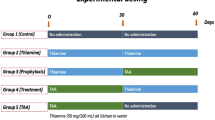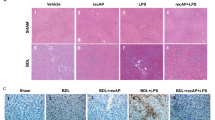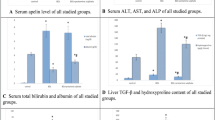Abstract
Background Acute liver failure is associated with a marked depletion of intrahepatic adenosine 5′-triphosphate (ATP), a compound required for the maintenance of hepatic function and enhanced hepatic regeneration. Aim The aim of this study was to test the safety and efficacy of exogenous ATP at various doses in a rat model of acute liver failure. Methods Adult male Sprague-Dawley rates (n = 56) received an intraperitoneal dose (1.0 g/kg) of the potent hepatotoxin d-galactosamine (d-galN). Thereafter, rats were divided into groups that received saline (n = 18), low (n = 8), moderate (n = 18) or high (n = 12) doses of ATP for 7 days. Results There was an inverse correlation between ATP dose and survival such that rats treated with low dose ATP had the highest survival rate (50%) compared to moderate (39%) and high (17%) dose treated groups. However, survival in all treated groups was similar (P = 0.085) to that of controls (45%). Liver biochemistry, regenerative activity and ATP levels were similar in the highest survival group (low dose ATP) versus controls. Conclusion These findings suggest that exogenous ATP does not improve and indeed at high doses may impair survival in rats with acute liver failure. Further studies involving a wider range of ATP doses and different routes and frequency of ATP administration are required to determine whether exogenous ATP has therapeutic value in the treatment of acute liver failure.



Similar content being viewed by others
References
Schiøt FV, Lee WM (2003) Fulminant liver disease. Clin Liver Dis 7:331–349
Bernal W, Wendon J (2004) Liver transplantation in adults with acute liver failure. J Hepatol 40:192–197
William ML (2003) Acute liver failure in the United States. Liver Dis 23:217–226
Schiødt FV, Atillasoy E, Shakil AO et al (1999) Etiology and outcome for 295 patients with acute liver failure in the United States. Liver Transpl Surg 5:29–34
Ostapowicz G, Fontana R, Schiødt FV, Larson A, Davern T, Han S, McCashland T, Shakil AO, Hay E, Hynan L, Crippin J, Blei A, Samuel G, Reisch J, Lee W U.S. Acute Liver Failure Study Group (2002) Results of a prospective study of acute liver failure at 17 tertiary care centers in the United States. Ann of Int Med 137:947–954
Williams R, Gimson AE (1991) Intensive liver care and management of acute hepatic failure. Dig Dis Sci. 36(6):820–826
Corbin IR, Buist R, Peeling J, Zhang M, Uhanova J, Minuk GY (2003) Utility of hepatic phosphorus-31 magnetic resonance spectroscopy in a rat model of acute liver failure. J Investig Med 51:42–49
Corbin I, Buist R, Peeling J, Zhang M, Uhanova J, Minuk GY (2003) Hepatic 31P MRS in rat models of chronic liver disease: assessing the extent and progression of disease. Gut 52:1046–1053
Corbin IR, Buist R, Volotovskyy V, Peeling J, Zhang M, Minuk GY (2002) Examination of regenerative activity and liver function following partial hepatectomy in the rat using P-MR spectroscopy. Hepatology 36:345–353
Agteresch HJ, Burgers SA, van der Gaast A, Wilson JH, Dagnelie PC (2003) Randomized clinical trial of adenosine 5′-triphosphate on tumor growth and survival in advanced lung cancer patients. Anticancer Drugs 14:639–644
Agteresch HJ, Dagnelie PC, Rietveld T, van den Berg JW, Danser AH, Wilson JH (2000) Pharmacokinetics of intravenous ATP in cancer patients. Eur J Clin Pharmacol 56:49–55
Terblanche J, Hickman R (1991) Animal models of fulminant hepatic failure. Dig Dis Sci 36:770–774
Muntane J, Rodriguez FJ, Segado O et al (2000) TNF-alpha dependent production of inducibile nitric oxide is involved in PGE (1) protection against acute liver injury. Gut 47:553–562
Mourelle M, Meza MA (1989) Colchicine prevents D-galactosamine-induced hepatitis. J Hepatol 8:165–172
Keppler D, Lesch R, Reutter W, Decker K (1968) Experimental hepatitis induced by D-galactosamine. Exp Mol Pathol 9:279–290
Assy N, Gong Y, Zhang M, Pettigrew NM, Pashniak D, Minuk GY (1998) Use of proliferating cell nuclear antigen as a marker of liver regeneration after partial hepatectomy in rats. J Lab Clin Med 131:251–256
Corbin IR, Minuk GY (2003) Serial percutaneous liver biopsies in the laboratory rat. Dig Dis Sci 48:1939–1943
Rapaport E, Fontaine J (1989) Generation of extracellular ATP in blood and its mediated inhibition of host weight loss in tumor-bearing mice. Biochem Pharmacol 38:4261–4266
Nagy JA (1992) Lymphatic and non lymphatic pathways of peritoneal absorption in mice: physiology versus pathology. Blood Puric 10:148–162
Lay CS, Tsai YT, Kong CW, Lee FY, Chang TT, Lin HC, Yang CM, Lee SD, Chiang BN, Lo KJ (1988) The influence of verapamil and nifedipine on hepatic indocyanine green clearance in patients with HBsAg-positive cirrhosis and ascites. Clin Pharmacol Ther 44:453–457
Sass DA, Shakil AO (2003) Fulminant hepatic failure. Gastroenterol Clin North Am 32:1195–1211
Cui TX, Iwai M, Hamai M, Minokoshi Y, Shimazu T, Horiuchi M (2000) Aggravation of chemically-induced injury in perfused rat liver by extracellular ATP. Life Sci 66(26) 2593–2601
Van de Meer C, Snijders PM, Valkenburg PW (1982) The effect of ATP on survival in intestinal ischemia shock, hemorrhagic shock and endotoxin shock in rats. Circ Shock 9:619–628
Lund P, Cornell NW, Krebs HA (1975) Effect of adenosine on the adenine nucleotide content and metabolism of hepatocytes. Biochem J 152:593–599
Anghileri LJ, Mayayo E, Domingo JL, Thouvenot P (2002) Toxic and carcinogenic effects of parenteral and percutaneous ATP and its iron complex. Drug Chem Toxicity 25:267–279
Leij-Halfwerk S, Agteresch HJ, Sijens PE, Dagnelie PC (2002) Adenosine triphosphate infusion increases liver energy status in advanced lung cancer patients: an in vivo 31P magnetic resonance spectroscopy study. Hepatology 35:421–424
Coutinho-Silva R, Stahl L, Cheung KK, Enes de Campos N, de Oliveira Souza C, Ojcius DM, Burnstock G (2005) P2X and P2Y purinergic receptors on human intestinal epithelial carcinoma cells: effects of extracellular nucleotides on apoptosis and cell proliferation. Am J Physiol Gastrointest Liver Physiol 288:G1024–G1035
Thevananther S, Sun H, Li D, Arjunan V, Awad SS, Wyllie S, Zimmerman TL, Goss JA, Karpen SJ (2004) Extracellular ATP activates c-jun N-terminal kinase signaling and cell cycle progression in hepatocytes. Hepatology 39:393–402
Acknowledgments
The authors would like to thank Mrs. S. Zdanuk for her prompt and accurate typing of the manuscript. Ms. Becker is the recipient of an INSERC Graduate Student Award.
Author information
Authors and Affiliations
Corresponding author
Rights and permissions
About this article
Cite this article
Becker, E.P., Sun, D. & Minuk, G.Y. Exogenous Adenosine 5′-triphosphate does not Improve Survival in Rats with Acute Liver Failure. Dig Dis Sci 53, 794–798 (2008). https://doi.org/10.1007/s10620-007-9940-z
Received:
Accepted:
Published:
Issue Date:
DOI: https://doi.org/10.1007/s10620-007-9940-z




